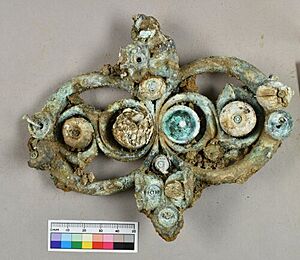Melsonby Hoard facts for kids
Quick facts for kids Melsonby Hoard |
|
|---|---|

A strap junction from the hoard
|
|
| Created | late 1st century BC - mid 1st century AD |
| Period/culture | Late Iron Age (British Iron Age) |
| Discovered | December 2021 Melsonby, North Yorkshire, England |
| Identification | YORYM-0E157E |
The Melsonby Hoard is a huge collection of ancient objects from the Iron Age in Britain. These items were found buried in a field near the village of Melsonby in North Yorkshire, England. A metal-detectorist named Peter Heads discovered the hoard in December 2021.
Expert archaeologists from Durham University carefully dug up the site in 2022. They received money for this important work from Historic England. The objects in the hoard are from the time of the Roman Empire. They teach us about ancient pottery, weapons, how wheels were used, and how people worked with metals. The hoard also shows us how people displayed their importance in society. This amazing discovery was announced in March 2025. At the same time, some of the items were put on display at the Yorkshire Museum in York.
Contents
Discovering the Hoard
How the Hoard Was Found
The Melsonby Hoard was found by Peter Heads, who enjoys searching for metal objects as a hobby. He found it in a field near Melsonby in December 2021. Because of its age and value, the hoard was immediately declared "treasure" under a special law.
Peter reported his discovery right away. This led to archaeologists from Durham University starting their dig in 2022. The British Museum gave advice, and Historic England provided funding. The University of Southampton also helped. They used special tools to sense the objects without damaging them.
Why the Hoard Is Important
Scientists who worked on the hoard said it is incredibly important worldwide. It is the largest collection of Iron Age metal objects ever found in Britain. The hoard was buried around the time the Romans took over southern Britain in the first century AD. The place where it was found is close to the Stanwick Iron Age Fortifications. This was a large Celtic hillfort from the same time period.
By March 2025, over 900 items had been found in the hoard. They were in two separate buried groups. The objects included beautiful decorations, an iron mirror, and 14 fancy pony harnesses. There were also horse bits, three decorative spears, and two large cauldrons. One cauldron might have been a special bowl for mixing wine. It shows a mix of Iron Age and Mediterranean styles.
The hoard also contained 28 iron tyres. These show that people used both four-wheeled wagons and two-wheeled chariots. There were at least seven vehicles in total. Another 88 objects were stuck together in a large lump. Experts are still working to separate and study them. The items are made from materials like copper alloy, iron, and Mediterranean coral.
Many objects were made colorful with glass and enamel. These luxury items were probably owned by someone very important. They were purposely damaged before being buried, likely on a large fire, but without bodies. This discovery makes experts rethink old ideas about power in the Iron Age. It shows that northern British leaders were just as powerful as southern ones. It also changes how we understand how wealth was shown back then. This find is truly special and unique for the British Iron Age.
Protecting and Displaying the Hoard
In March 2025, the Yorkshire Museum started asking the public for help. They needed to raise £500,000 to buy and take care of the hoard. The hoard has been valued at £254,000. Under the Treasure Act 1996, the museum has the chance to buy it for this price. If they cannot raise enough money, the hoard might be sold. It could even be split up or moved to another country. Taking care of the hoard is expected to cost another £250,000. The museum began showing some items from the hoard on March 25, 2025.
See also
- Stanwick Hoard – a similar Iron Age find in Melsonby from 1845


